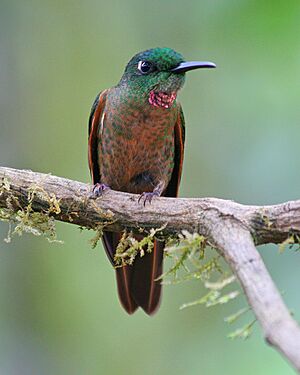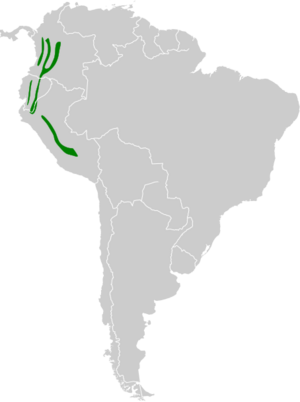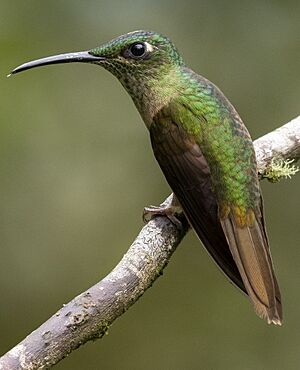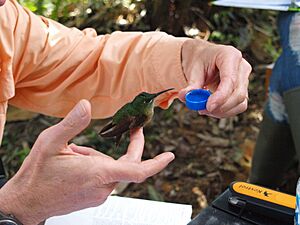Fawn-breasted brilliant facts for kids
Quick facts for kids Fawn-breasted brilliant |
|
|---|---|
 |
|
| Conservation status | |
| Scientific classification | |
| Genus: |
Heliodoxa
|
| Species: |
rubinoides
|
 |
|
The fawn-breasted brilliant (Heliodoxa rubinoides) is a stunning type of hummingbird. These tiny, colorful birds live in South America. You can find them in countries like Bolivia, Colombia, Ecuador, and Peru.
People sometimes call this bird the lilac-throated brilliant in English. In Spanish, it has names like brillante pechigamuza, colibrí de vientre ocre, and diamante pechigamuza.
Contents
What Does the Fawn-breasted Brilliant Look Like?
This hummingbird has bright green feathers on its back. Its belly is a shiny, iridescent copper color. It also has patches of fawn (a light brown) and green, with copper spots.
The fawn-breasted brilliant has a long, slightly curved beak. This special beak helps it reach nectar deep inside flowers.
Where Does the Fawn-breasted Brilliant Live?
The fawn-breasted brilliant lives in the Andes Mountains of South America. Different groups of these birds live on different slopes of these mountains.
It prefers to live in tropical forests. While it might be a bit hard to spot sometimes, its numbers are stable. The International Union for Conservation of Nature says it is a species of "least concern." This means it is not currently at high risk of disappearing.
There are three main types, or subspecies, of the fawn-breasted brilliant:
- Heliodoxa rubinoides aequatorialis: Found in Colombia and Ecuador, on the western side of the Andes.
- Heliodoxa rubinoides cervinigularis: Lives in Ecuador and Peru, on the eastern side of the Andes.
- Heliodoxa rubinoides rubinoides: Found in Colombia, in the central and eastern Andes.
How Does the Fawn-breasted Brilliant Live?
What Does it Eat?
The main food for the fawn-breasted brilliant is nectar from flowers. Nectar is a sweet liquid that gives the birds energy.
These hummingbirds are very protective of their favorite flowers. They will chase away other animals that want the nectar, even insects like bumblebees! When feeding, they can hover in front of a flower. They can also hang upside down from it. Their long tongue goes in and out up to 13 times every second to drink the nectar.
Fawn-breasted brilliants also visit bird feeders. They will even drink water from fountains and bird baths. Besides nectar, they eat small insects and spiders. These tiny creatures give them extra protein. Female hummingbirds catch many insects when they are raising chicks. This is because insects are a very important food for growing baby birds. The birds catch insects by flying out to grab them in the air. They also pick them off plants or even pluck them from spider webs.
Reproduction and Family Life
Fawn-breasted brilliants are usually alone. They only come together during breeding season. The male bird performs a special courtship display to attract a female. He flies in U-shaped patterns in front of her.
After mating, the male does not help with building the nest or raising the babies. Both male and female birds may mate with several partners.
The female builds a cozy nest in a shrub or tree. She uses plant fibers, spider webs, animal hairs, and soft down. She covers the outside of the nest with moss. This helps to camouflage the nest so predators can't easily see it.
She lays two small, white eggs. When the chicks hatch, the mother feeds them. She brings them insect material that she has partly digested. Baby hummingbirds need insects to grow strong, not just nectar. The mother sits on the chicks to keep them warm for about 12 days. After that, the chicks grow too big for her to fit in the nest with them. The young birds are ready to leave the nest when they are about 20 days old.
What Sounds Does it Make?
The fawn-breasted brilliant makes two main types of sounds. One is a series of "tchik" notes. The other is a common call that sounds like "swi-swi-swi-swu." These vocalizations help them talk to other hummingbirds.




